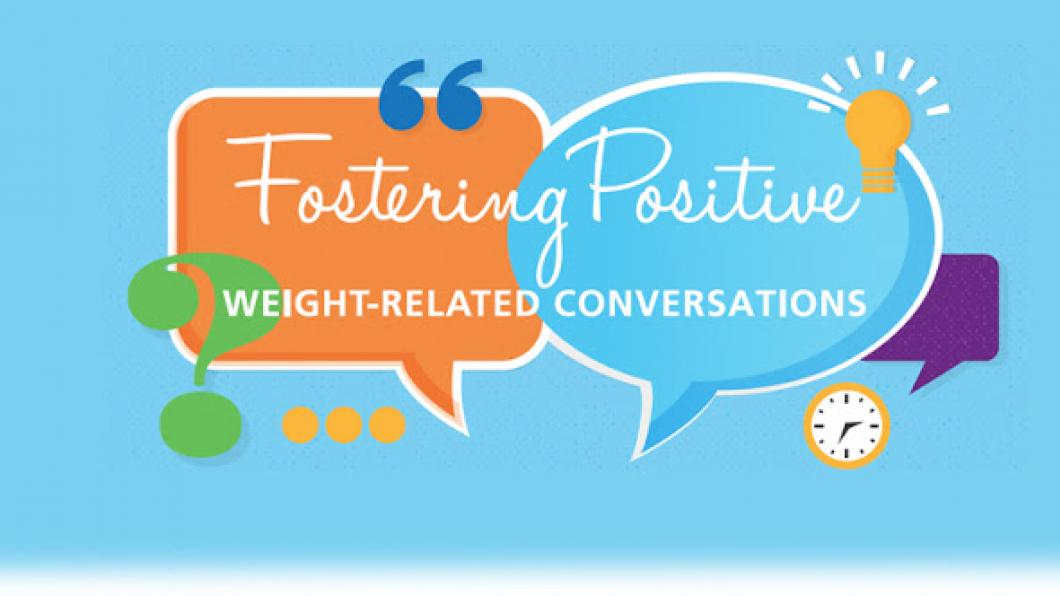
Talking to kids about weight: What works and what doesn't?
By Louise Kinross
Last month the American Academy of Pediatrics released a policy statement on how children with obesity are stigmatized, and how health professionals can help reduce that stigma when talking about weight.
This month, Holland Bloorview launched an interactive casebook on how to have positive conversations about weight and health with children, including those with disabilities. The book focuses on healthy lifestyles and is written for health professionals across disciplines
It brings together the latest research, video stories from clinicians and families, simulations and resources.
BLOOM interviewed Amy McPherson, a Holland Bloorview scientist who authored the casebook with knowledge translation specialist Christine Provvidenza and post-doctoral fellow Laura Hartman. A multi-disciplinary team also worked on the project and input came from experts across Canada.
BLOOM: In what way is weight an issue for children?
Amy McPherson: One in three kids in Canada has overweight or obesity. Kids with disabilities are two to three times more likely than their peers to experience this.
BLOOM: Why do you say kids ‘have,’ as opposed to, ‘are’ overweight?
Amy McPherson: It’s person-first language. We’re trying to get across that obesity is a disease, like diabetes, so something you have and not something you are. This is the language recommended by the Canadian Obesity Network.
BLOOM: What is a casebook?
Amy McPherson: A casebook helps bridge the gap between what we know and what we do in health clinics. It combines research evidence, experience and resources in one place and provides practical clinical guidance to heath professionals who work with children.
BLOOM: Why is a casebook needed?
Amy McPherson: We know that health-care professionals who work with children report that they don’t feel confident having discussions about weight. They don’t feel like they have the training to bring up these issues. They’re often worried that they’ll ruin a therapeutic relationship they have with a child and family by offending parents and children, or will cause self-esteem issues in the child. That speaks to the weight bias in our society. Why would having a higher weight be any different than having blue eyes? We associate negativity with weight, and so we’re reluctant to mention it.
BLOOM: What should professionals know about higher weights?
Amy McPherson: One of the main messages in the book is that obesity is not a personal choice. It’s complex, and affected by many factors. It’s not a case of ‘eat less and exercise more.’ If it was that easy, no one would have obesity. Genetics influence weight, as does sleep and your metabolism and medication. When you lose weight, your body actively fights it.
We encourage professionals to talk about growth and health rather than weight and size. If they are tracking a child’s growth and they see a steep trajectory, that may be an opportunity to step in and talk about the impact of weight on health.
BLOOM: What are the key messages you want to get to professionals and families?
Amy McPherson: One is that before talking about weight-related topics with a child, ask for permission. First, make sure you’re in a private environment and the child feels comfortable. Ideally they will know the professional. If the child doesn’t want to talk about it, say ‘Okay, we’ll revisit it next time’ and ‘It’s always okay to come back and talk to me, or someone else, about it.’ We need to build rapport with families who might be sensitive about it.
BLOOM: What are other suggestions in the book?
Amy McPherson: To recognize the strengths of children and families and what they’re doing well. Almost anything can be made into a success, and can be used with the child and parents to motivate and engage them. Perhaps they made Tuesday a pop-free day. That’s awesome. Focus on solutions. Maybe they turned off the TV earlier than usual and played a game outside. Find where their strengths are.
BLOOM: How is the book different from reading a research paper?
Amy McPherson: We wanted to make it really practical so it could be used in everyday practice. To create the content, we held two workshops with researchers, clinicians, students, parents and youth. We wanted to make sure that people with different learning styles could benefit. So we include diagrams and videos. We have evidence-based research summaries in there but we break everything down. For example, we have six sentence starters for clinicians who don’t know how to bring up the topic. We have four simulations to spark conversation on what works and what doesn't. There’s a one-pager clinicians may want to stick on the wall.
BLOOM: I’m wondering if one of the reasons health workers don’t want to address weight is that there isn’t an easy answer in terms of treatment.
Amy McPherson: Weight management in all children has a low success rate. We haven’t worked out exactly how to do it with typically developing children. With children with disabilities, there are extra complexities. We need more research to offer recommendations on weight management. But if we can get professionals talking about being active and eating well for your health, and not make it about weight and a number on the scale, that may have benefits. We want to give the message that the whole family can get involved in moving more and feeling good about their bodies.
BLOOM: What are next steps?
Amy McPherson: We’ve applied for Centre for Leadership funding at Holland Bloorview to do an implementation study. We’d like to work with a group of clinicians and trainees here to create a curriculum and a road map of ‘this is what you do to get this into your clinic.’ We would identify the gems that are immediately useful. We’d also like to target a number of clinics across Canada to look at the impact of using the casebook and whether it’s changing behaviour.